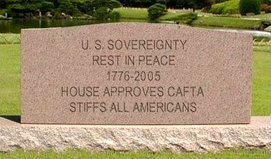Katrina Deaths Lead to Real-Life 'CSI'
By CONNIE MABIN, Associated Press WriterSun Dec 11, 7:44 AM ET
While hundreds drowned in Hurricane Katrina's filthy floodwaters, at least 21 people died more mysteriously. From unexplained gunshot wounds to stabbings and fatal blows to the head, these unidentified victims are now the main characters in a real-life version of "CSI."
Coroners are using science, creative thinking — and even a Crock-Pot — to try to answer the question many are asking: Who or what killed these 21 people?
With evidence that's washed away, witnesses who fled the state and an overworked police department, at least one official says the mysteries may never be solved.
"We don't know if they are suicide or murder or accident," says New Orleans coroner Dr. Frank Minyard. "We may never know."
Coroners examining the 1,090 bodies recovered in and around New Orleans occasionally find something suspicious — a bullet lodged in a bone, a wound that could match a knife blade.
When that happens, they set the bodies aside for a closer look, and notify the police and district attorney, said Dr. Louis Cataldie, the state medical examiner.
New Orleans police spokesman Capt. Juan Quinton said his department investigates when the coroner declares a homicide, but he's unaware of "any great volume" of deaths unrelated to the storm. He refused to discuss details of any ongoing homicide cases because the coroner has yet to release names.
Orleans Parish District Attorney Eddie Jordan and his staff are investigating four homicides that occurred in the aftermath of the hurricane: one at the Superdome, one at the city's convention center and two "on the street," said spokeswoman Leatrice Dupre.
Included in the morgue's mysterious 21 — but not among the four on the DA's homicide list — are the police-shooting deaths of two people in September. Cops say the men were among gunmen who opened fire on contractors traveling across the Danzinger Bridge on their way to make repairs. The family of one of the dead disputes the men were shooting at anyone, and Jordan's office is investigating. The family's lawyer has advised them not to speak to reporters.
"Those shootings may very well be determined to be justifiable; they may not be," Dupre said.
The 21 mystery cases are in limbo until Minyard and his small staff can re-examine the bodies for clues. Their priority now is identifying the remains of hundreds of drowning victims in the state's temporary morgue so they can be returned to families.
When the investigation does begin, Minyard's team will face challenges: Flooding not only washed away evidence from crime scenes but also forced both perpetrators and potential witnesses to flee.
And New Orleans' government is still wrecked in many ways. The police department is in the midst of a leadership shake-up, the courts are barely functional and the coroner's staff has been cut by three-fourths because Katrina broke the city budget.
Still, Cataldie predicts no one will get away with murder because there's one piece of evidence the storm didn't wash away: the corpse. "Don't forget that the body is a crime scene. Always," he said.
At the top of the to-do list is retrieving bullets for ballistics tests to see if the gun has been used in other crimes.
Skeletons also yield evidence.
"You can take a rib and cook it down," he said. "You can deflesh it, and we do that in a Crock-Pot, and find a nick that would indicate a stab wound. There are all kinds of things you can find — scratches and nicks that don't belong there."
However, Cataldie stressed, what may look like stab wounds may very well be the marks of animals preying on the dead.
"There's definitely carnavoric activity on many of the bones we're seeing," he said.
And not all human-inflicted wounds lead to murder. Cataldie said he examined the body of a man who died during the storm who police believe had been slain.
"It was quite obvious the gunshot wound to the head was an old gunshot wound because there actually had been surgery. So the person was not a homicide, he was a drowning victim," he said.
In late October, prominent forensic pathologist Dr. Cyril Wecht, the coroner in Pittsburgh, helped Minyard with 30 Katrina-related autopsies, including one shooting victim.
"I cannot tell you whether it was homicide or suicide," Wecht said. "I really don't know."
The condition of the bodies made immediate determination of the cause of death difficult, he said. Often, bodies were so badly decomposed there was no blood, no obvious organs and in many cases, injuries that were sustained after death, possibly by encounters with debris.
Coroners tried to rule out foul play by looking for — and not finding — obvious signs: bullets, stab wounds, skull fractures, bodies found someplace other than in water. And every victim had pieces of their leg bones removed for DNA testing to help with identification.
In suspected cases of mercy killings in hospitals or nursing homes, tissue was sent to a Philadelphia lab to test for morphine and other drugs.
But Wecht, who said he's never seen so many bodies from so many places in such bad condition, said medical examiners can only determine so much.
"I think in many incidents, it's going to be impossible," he said. To him, the best service coroners can offer in this situation is identification.
Still, Darlene Cusanza, executive director of the New Orleans Crime Stoppers organization, said her group is counting on the coroners and law enforcement to do everything they can to solve the mysterious deaths.
"There will be justice. It just may take a while," she said. "Nothing is being forgotten."
Cataldie is also confident the murders will someday be solved, not only with clues left behind by the dead, but with help from the living.
"Most homicides, despite what you see on 'CSI,' are not solved by forensics," he said. "Most homicides are solved by people talking. People talk."
___
On the Net:
Crime Stoppers: http://crimestoppersgno
Subscribe to:
Post Comments (Atom)








No comments:
Post a Comment